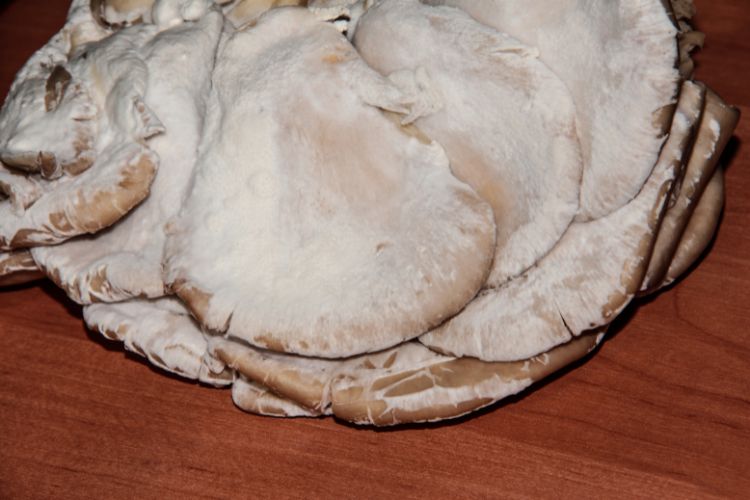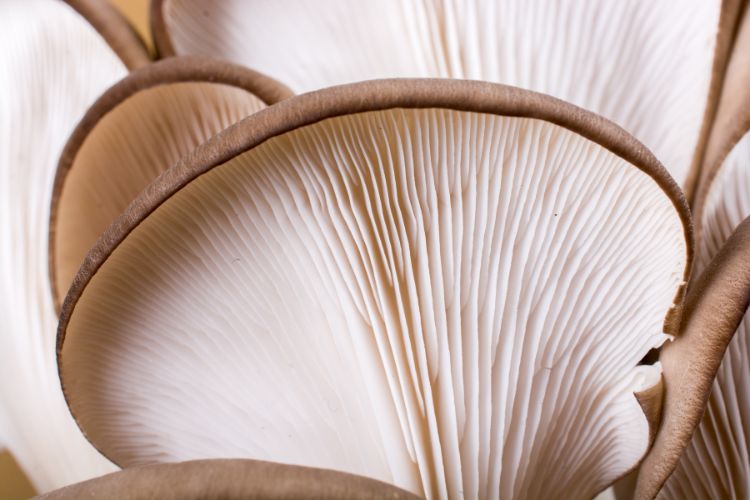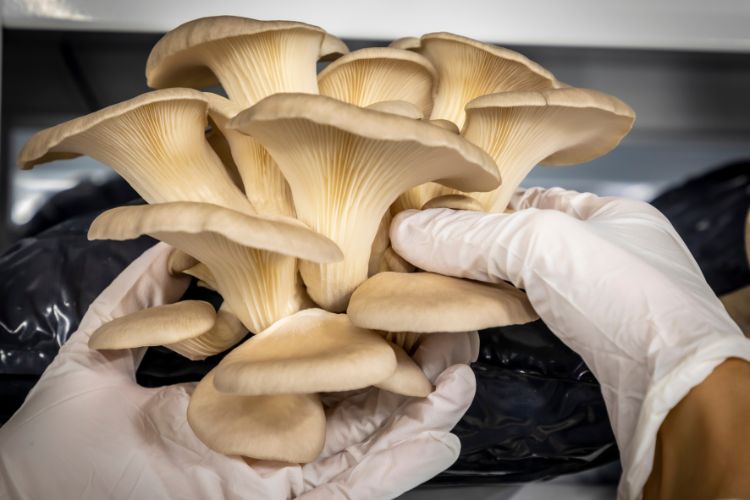Have you ever brought home a bunch of oyster mushrooms to cook a delicious meal, only to discover a strange, white fuzz on them?
Have you ever brought home a bunch of oyster mushrooms to cook a delicious meal, only to discover a strange, white fuzz on them? Don’t worry; you’re not alone. Finding mold on oyster mushrooms is a common occurrence and sometimes a bit puzzling.
In this article, we’ll explore the different mold types that can affect oyster mushrooms, understand why they occur, and learn how to spot them. So, keep reading.
Types of Mold on Oyster Mushrooms
Mold on oyster mushrooms comes in various forms, each with its own distinct characteristics. Understanding the differences among these mold types is vital in addressing them appropriately.
Take a closer look at these different types of mold that can make their home on your beloved mushrooms.
A. White Mold

White mold appears as a cotton-like layer of fuzz on mushrooms. It often starts as tiny, white spots that grow over time.
Such a type of mold typically develops in conditions of high humidity and poor air circulation. To distinguish white mold from other types, look for its fluffy, bright appearance. When touched, it feels soft and resembles cotton candy.
B. Cobweb Mold
Cobweb mold, as the name suggests, resembles delicate cobwebs. It forms a fine, web-like network over the mushrooms, often in patches.
Usually thriving in highly humid environments, cobweb mold can spread quickly. Luckily, identifying it is relatively easy. That’s due to its unique appearance, resembling fine white threads or cobwebs covering the mushrooms.
C. Other Mold Varieties
White and cobweb molds are among the most common culprits. Yet, when it comes to moldy oyster mushrooms, there can be other varieties as well. These might include green or blue molds, which can be less frequent but are equally vital to recognize.
So, keep an eye out for any unusual discolorations, textures, or growths on your mushrooms.
Causes of Mold Growth on Oyster Mushrooms
Moldy oyster mushrooms can be a common kitchen conundrum. Thus, understanding the reasons behind their moldy appearances can help you prevent such issues later on. Take a look at a few factors that lead to mold growth on these delectable fungi.

1. High Humidity
One of the primary reasons mold can find its way onto oyster mushrooms is high humidity. Naturally, mushrooms are moist. Therefore, when stored in a humid environment, it creates the perfect conditions for mold to thrive.
Typically, mold spores are present everywhere, but they need moisture to grow. So, to prevent this, ensure that you store your mushrooms in a dry and well-ventilated space.
2. Poor Air Circulation
Mold loves still air. By nature, if you keep your mushrooms in a place with poor airflow, it can encourage mold growth. Without fresh air circulation, moisture lingers around the mushrooms. Consequently, this makes them vulnerable to mold infestation.
To combat this, make sure your mushrooms have room to “breathe.”
3. Contaminated Environment
A contaminated environment can also introduce mold spores to your oyster mushrooms. If your kitchen or storage area has a history of mold issues, it’s more likely that your mushrooms will be affected as well.
That’s why it’s essential to maintain cleanliness during mushroom handling.
4. Improper Storage
Improper storage conditions can also lead to mold issues. For instance, storing mushrooms in sealed plastic bags can trap moisture. In turn, this creates a mold-friendly environment.
To prevent this, consider using paper towels or paper bags to store your mushrooms. These materials help absorb excess moisture and maintain the mushrooms’ natural freshness.
Identifying Mold on Oyster Mushrooms
Mold can be a sneaky intruder on your oyster mushrooms. Fortunately, spotting it early is the key to ensuring your culinary creations remain safe and delicious. Here’s how to identify mold on oyster mushrooms.

A. Visual Cues
When it comes to identifying mold on oyster mushrooms, your eyes are your best allies. Oftentimes, mold appears as irregular spots or patches on the mushroom’s surface. It can range in color from white to green, blue, or even gray, depending on the type of mold.
Usually, mold spots are distinct from the mushroom’s natural color and texture. Thus, you need to keep a close eye on your oyster mushrooms. If you notice any areas that look different or suspicious, it might be mold.
B. Texture
The texture of moldy areas on oyster mushrooms differs from the mushroom’s natural texture. While oyster mushrooms typically have a smooth and somewhat slimy texture, mold feels different to the touch.
In general, moldy parts can be fuzzy, slimy, or spongy. When you run your fingers over the surface, you may notice an uneven or unusual texture in the affected areas, indicating the presence of mold.
C. Smell
Moldy oyster mushrooms often emit a distinctive and unpleasant odor. If you detect a musty, earthy smell that is not typical of fresh oyster mushrooms, it’s a sign that mold may have taken hold.
Such a smell is a valuable indicator, helping you avoid the consumption of potentially harmful moldy mushrooms.
Tips To Prevent Mold on Oyster Mushrooms
The good news is that you can take steps to prevent mold growth on oyster mushrooms. Here are a few helpful tips.
- Store oyster mushrooms in a breathable container or a paper bag.
- Avoid using sealed plastic bags that trap moisture.
- Maintain the right humidity level in your storage area, aiming for lower humidity.
- Consider using a dehumidifier if your storage space is too humid.
- Wash your hands before handling oyster mushrooms to prevent contamination.
- Keep the environment where you prepare and store mushrooms clean.
- Use oyster mushrooms soon after purchase to reduce the chances of mold growth.
- Plan your recipes to make the most of your mushrooms while fresh, making a sauce for a juicy piece of steak for example (see also: How To Season Steak).
Final Thoughts
In your culinary journey, you might meet mold on oyster mushrooms. As annoying as mold can be, it’s an avoidable occurrence. You just need to take care of your freshly-bought mushrooms to prolong their freshness.
Remember that proper storage, humidity control, cleaning, and handling can help greatly in keeping your batch of oyster mushrooms mold-free. So, don’t overlook such essential precautions.
- How To Fill a King Cake With Bavarian Cream - April 15, 2024
- Dealing With Mold on Oyster Mushrooms - April 9, 2024
- What Meat Goes With Pumpkin Ravioli? (Ravishing Ravioli Combos) - March 15, 2024
